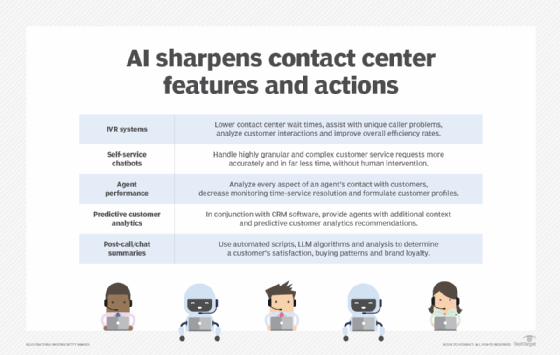5 key contact center AI features and their benefits
As multifunctional contact centers evolve in complexity and importance, AI and GenAI integration are advancing self-service chatbots, customer insights and agent monitoring.
Contact centers are an effective way to take advantage of the latest advancements in AI and generative AI. These technologies deliver businesses rapid ROI and actionable insights that can streamline processes and improve operational efficiency.
AI can accurately and conveniently service contact center customers across several communications channels using voice and text. Additionally, businesses can take advantage of improved contact center visibility through AI-derived analytics, metrics and KPIs.
2 main types of contact center AI
The first category of AI typically integrated into contact centers is conversational AI, which uses large language model (LLM) algorithms. This technology lets customers converse with voice- and text-based interactive voice response (IVR) systems, chatbots and virtual assistants.
LLMs employ natural language processing capabilities that let the contact center software understand the various nuances of written and verbal communication. This capability makes conversational AI a good fit to bolster the customer service engagement and service fulfillment process without increasing staffing levels. The ability of conversational AI to analyze, retrieve, predict and pass on information in multiple written or spoken formats helps take the customer contact center experience to a more efficient level with little Opex overhead.
The second type of contact center AI uses data analysis to sift through various statistics and KPIs and make suggestions on ways to improve performance or increase customer satisfaction. This type of AI helps contact center operators meet their performance goals without having to manually sift through and analyze data using manual or semiautomated processes.

5 popular contact center AI features
IVR systems, chatbots, agent coaching and monitoring, predictive analytics and generative AI capabilities are among the more popular and beneficial features integrated into contact center platforms.
1. Interactive voice response
Most contact centers use IVR in one capacity or another. These speech-enabled, automated systems use voice prompts to help callers navigate call tree menus or access information without the need for a human operator. With the advent of AI-backed IVR, however, these automated voice systems are lowering call center wait times, assisting with unique caller problems, and improving overall customer call center and contact center efficiency rates. AI analyzes past customer interactions and uses extrapolative analysis to predict the wants and desires of a customer. Additionally, AI integrated into an IVR system can tap into contact center agent training data to learn how to handle routine tasks and typical customer inquiries. AI can then direct callers to the information they require or the customer agent that can best handle their needs.
2. Self-service chatbots and virtual agents
IM and live chat products have been around for decades, but compared to traditional methods, contact center chatbots using AI don't require human agents. While recent surveys show that contact center users still prefer to work with a human agent, this preference is quickly trending downward as customers get more comfortable with virtual agent interactions. Conversational AI chatbots and virtual agents are also achieving a level of sophistication to handle highly granular and complex customer self-service requests more accurately and in far less time.
3. Real-time agent coaching and performance monitoring
At this stage, most contact centers still use a combination of AI IVR, chatbots, virtual assistants and human agents. But, when it comes to the human aspect of the contact center, a different form of AI is improving the customer service experience. Nearly every aspect of a human agent's contact with customers can be analyzed using AI. Examples of collected metrics include call and chat logs, handle times, time-to-service resolution, queue times, hold times and customer survey results. All this information is collected and analyzed to determine how customer satisfaction can increase, while simultaneously decreasing time-to-service resolution. AI is used to track these statistics, formulate performance profiles and make automated coaching suggestions to agents.
4. Automatic call insights with predictive analytics
CRM software is commonly used in conjunction with contact center platforms. CRM systems store a wealth of customer-related data, including contact information, purchase preferences, purchase decisions and any previous interaction touchpoints the business has had with the customer. Using this information, relevant CRM data can be intelligently fed to human agents or chatbots to provide additional context and predictive analytics recommendations as soon as a customer communicates with the contact center.
5. AI-generated transcription, call and chat summaries
A combination of automated scripts, LLM algorithms and customer analysis techniques can be used to transcribe, organize and analyze post-call and post-chat summaries. This data can then be input into a CRM system and further analyzed to determine various aspects of a customer's interaction with the contact center, including their overall satisfaction, likelihood of purchasing products and services in the future, brand loyalty, and which targeted marketing and sales methods are most likely to translate into future sales.
Andrew Froehlich is founder of InfraMomentum, an enterprise IT research and analyst firm, and president of West Gate Networks, an IT consulting company. He has been involved in enterprise IT for more than 20 years.








